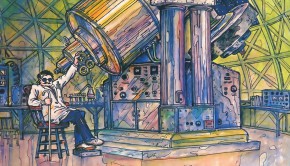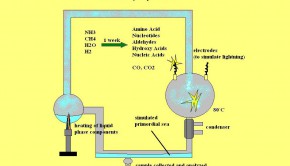Another Jolt For Evolution Theory
He takes 10 so-called proofs of evolution offered in current textbooks and shows where not one of them is in a fact a proof of anything, and several are actually frauds.
FROM THE EDMONTON SUN
If parents check the science textbooks used in Canadian schools they’ll see some familiar illustrations, familiar because much the same art appeared in their textbooks.
There’s the “evolution of man” illustration, starting with an ape-like creature on the left, then progressing to the slightly more erect figure with arms stretching to the ground, then to a less hairy individual, finally to a modern human.
There’s the upside-down tree illustration, beginning with the blob, the single cell, at the top and branching out like a tree as it descends downward to assortments of creeping and crawling things to reptiles, birds, fish, animals and humans.
|
Or there’s the fruit fly illustrations, showing how some fruit flies change to double-winged creatures under certain conditions or the speckled moth illustration showing how industrial conditions caused moths to change from white creatures to black.
Note that there are three points being made here. One is that an amazing assortment of species have existed over time.
The second is that the more elaborate species were the offspring after many generations of earlier less complex species.
The third is that these changes occurred through natural circumstances. There was no “mind” or plan or design behind them, no God. It was all pure chance.
When most scientists speak of “evolution” they do not mean the first, nor even the first and the second. They mean all three, that there was no designer, that change happens through “natural selection.” Freak differences occurred in individual members of a species conferring a natural advantage on the offspring of those individuals. These went on living, where those without the advantage petered out, the “survival of the fittest.”
This fall there has appeared a scientifically authoritative book casting grave doubt on the whole basis of these confident illustrations. Dr. Jonathan Wells, a molecular and cell biologist from the University of California at Berkeley who is a senior fellow of the Discovery Institute, in his Icons of Evolution does more than cast doubt.
He takes 10 so-called “proofs” of evolution offered in current textbooks and shows where not one of them is in a fact a proof of anything, and several are actually frauds. The speckled moths were actually pasted on the trees, not found there. And while there may be rare instances of species that seem part ape, part human, there is no evidence the one came from the other.
Why, you wonder, do scientists ascribe credibility to these proofs?
Because, says Dr. Wells, every scientist specializes. He may be aware the particular “proof” offered in his own area of expertise is fundamentally flawed, but he assumes those in all the other areas are not. In fact, he says, they all are.
Wells’s book is the second in two years to challenge the natural selection theory. The last one was Darwin’s Black Box by the biochemist Michael Behe. He examines the blob atop the tree illustration.
In Darwin’s day the simple cell was a “black box” that could not be opened.
Now, says Behe, we have opened the box; we can see how the cell is constructed. It’s about as simple as a jet engine. It is a masterpiece of design. There is no possibility, none whatever, he says, that it could have come about by mere happenstance.
Both these books follow an earlier one by Berkeley law professor Philip Johnson whose Darwin On Trial put the theory of natural selection before a make-believe jury, and gave the evidence for it as it would be presented in court. He shows how the supposed evidence, all of it, fails to vindicate the theory.
Yet when the Kansas school system last year decided that evolution need no longer be taught as a scientific fact, but could be advanced as a theory with the students urged to argue the pros and cons, the response all over the continent was explosive. Papers like the Edmonton Journal and Globe and Mail denounced the Kansas board as perverted by superstition and religious bigotry. They made not a single reference to the scientific basis of the decision.
Evolution by natural selection, says Johnson, is the “creation myth of the 20th Century.” Wells agrees. Perhaps the 21st will get a better one.















Haribol, a new aspiring devoote here.
I have a question I was reminded of while reading the comments.
If there are 8 400 000 species than how come that some have become extinct (the dodo, bristolia, the Tasmanian tiger and many more, some of them very recently and others a long time ago)? What happens then? Does the Supreme Personality of Godhead simply invent a new species to take its place? A friend of mine brought this up once and I’m confused now.
Also, would the Neandertals be classified as a human species along with the other 400,000 human forms of life mentioned in the scriptures? They did appear human and reportedly buried their dead, which could indicate some kind of religious belief.
Hare Krishna Draupadi
The 8,400,000 species is the total number in the whole material creation. They are not all present on this earth planet. We do not have 400,000 species of humans, for example, on this planet. So this is the number for the whole material creation.
And some appear and disappear according to the situation. Krishna does not invent new species. The forms are there, on the subtle platform, and when the situation becomes conducive for a particular form it can be manifest.
Yes. Probably the neandertals would be classified as one of the human species. It is not exactly ‘species’ as we understand it from biology. It is forms. So we have a few different human forms like the arian people, the Africans, the Chinese, etc. So these are counted as separate human forms. But we don’t have anywhere near 400,000 human forms.
Chant Hare Krishna and be happy!
Madhudvisa dasa
Clearly the author of this article has no idea what he is talking about. Evolution by natural selection (microevolution) has nothing to do with macroevolution, the theory that life originated by evolution itself. Natural selection is as real as God Himself. Natural selection is the idea that the organisms with the best characteristics tend to survive (no one will deny this), and only surviving or living organisms can reproduce (obviously–nothing dead can reproduce), so over time, populations tend to evolve to fit their environment because the best characteristics slowly fill the gene pool. For example, with bacteria, most are killed by certain antibiotics, but in every bacteria population, a few “freaks” will be able to survive. Once they reproduce, they will compensate for all the missing bacteria. Those antibiotics won’t work anymore then. Scientists have directly observed this because bacteria reproduce so quickly. This is why new vaccines have to be made every year–bacteria keep evolving to the old ones.
Macroevolution–the idea that life originated as a result of evolution without a divine principle–is still very much controversial. Macroevolution has little to do with natural selection. Therefore, don’t have the misconception that evolution by natural selection and Hindu creationism are at odds.
Hare Krishna
You are correct of course that microevolution does happen and the Vedic scriptures do not say anything against this. It is selective breeding and this is actually a Vedic science. It is one of the sciences that Sandipani Muni taught Krishna and Balaram when they studied at his gurukula. So there is no argument here. However this selective breeding can only modify the characteristics of a species in small ways depending on the environmental circumstances. But the original ‘pattern’ of the species remains the same.
For example in Australia some people coming from England back in the 1700’s came with some pet white rabbits. And some escaped into the wild. And after a few generations they turned back into the original ordinary brown rabbits. So they were selectively bread in the beginning to become white rabbits but when put back into nature and without the selective breeding they soon turned back into the original normal brown rabbits. So there is an overriding ‘pattern’ of all the 8,400,000 species of life stored in the ether that remains the same. The number of species is constant and does not change. The same species continue to exist even after the total destruction of the universe. And when the universes are recreated the exact same 8,400,000 species will come out again. So there is no evolution of the species.
It is a little confusing when you say: “Macroevolution–the idea that life originated as a result of evolution without a divine principle–is still very much controversial.” You definition of macroevolution is not correct. Macroevolution does not refer to life originating as the result of evolution. Any scientist will agree of course that life can not evolve by the process of evolution. It is very clear and everyone accepts that evolution can only act when life is already existing. Evolution is based on the principle of ‘natural selection’. So there has to be already life that can be selected by evolution. Therefore your definition of macroevoltion is completely incorrect. No scientist who has even half a brain will ever suggest that evolution explains the original formation of life. That is a different thing altogether, the original creation of life. It has nothing to do with macroevoltion.
Macroevolution as far as I am aware refers to the theory that gradually by natural selection one species can transform itself into another species. They propose for example that the fish got out of the water and turned into birds, by natural selection. But fish do not turn into birds. There is no evidence that this ever happened.
When the western scientists speak of evolution it is almost always referring to macroevolution. Microevolution is not at all controversial. Everyone accepts that it happens.
So what scientists are generally speaking of when they refer to evolution is the false theory that one species can evolve into another species. And this is incorrect. The Vedic scriptures do not support this theory at all. The Vedic scriptures give us the information that there is a fixed number of species, 8,400,000, and of course within these species selective breeding can be done and small changes can be made in this way or by ‘natural selection’. But a rabbit will always be a rabbit. A fish will always be a fish. A fish can never evolve into a rabbit.
There is a type of evolution documented in the Vedic literatures, in two ways actually. In the early stages of the creation of this planet earth for example the whole planet is completely covered by water. So obviously there are only aquatics in the beginning. And then gradually the water dries up and land comes out. So the life comes from the water to the land. But it does not actually evolve as the scientists mistakenly imagine. No. The ‘blueprints’ for the species that live on the land already exist. Even when the earth is still totally covered by water, the land animals still exist in subtle form. So when their habitat comes out of the water then the land species also become manifest. So the Vedas do describe a sequence. First there are aquatics then plants, then insects, then birds, etc… It is very elaborately described in Srimad-Bhagavatam, you can get more detailed information there.
But the real evolution described in the Vedas is not the evolution of the material bodies but an evolution of consciousness. What happens is the living entities are placed in one of the 8,400,000 species of life according to their consciousness and as the living entities consciousness develops he is promoted to more advanced species of life. So the spirit soul’s consciousness is evolving and as a result he gets more evolved bodies. It is not that the bodies are evolving, changing from one species to another.
So the Vedas certainly disagrees with what scientists generally refer to as evolution, which is macro-evolution.
There is no argument with anyone at all that micro-evolution happens. So this is not an issue that anyone really discusses at all because there is no disagreement on this point.
Chant Hare Krishna and be happy!
Madhudvisa dasa
The other Michael mentioned;
“How could life manifest on Earth 3.8 billion years ago when the planet was a molten ball of metals and toxic gases?”
What makes you think that was the time frame?
“How could 47 phyla evolve from just three during the cambrian explosion?”
Why do you think they couldn’t?
“How could so much life evolve from virtually nothing after the permian extinction?”
Vaste amounts of time.
“Why did australopithecine apes evolve into bipedalism? Bipedal apes were unable to walk properly let alone run from predators and they were less adept in arboreal environments. Why did they evolve into weakness?”
The fact that they did shows it wasn’t a weakness.
“Why did Mother Nature allow the ‘natural’ evolution of an aberration unto herself, namely, Homo Sapiens Sapiens?”
If aberrations didn’t happen in nature, why would we even have a word for it?
It would be useful to have a link to whatever this was a response to.
“When most scientists speak of “evolution” they do not mean the first, nor even the first and the second. They mean all three, that there was no designer, that change happens through “natural selection.” ”
I think that’s a stretch with respect to the lack of a designer. There are plenty of theists who believe in evolution. It’s true that evolution doesn’t need deities to function, but it doesn’t need the specific lack of deities either.
” The speckled moths were actually pasted on the trees, not found there.”
That claim needs a reference, but even if it had one, it would be missing the point. The famous issue with the moths’ coloration was the discovery that the moths’ coloration was an acquired trait, not an inherited one. That makes it inappropriate as an example of evolution. The things is, the author of this article seems to be rather out of date, because as far as I know that’s been common knowledge for twenty years. I suppose it wouldn’t be that hard to find a twenty year old textbook in circulation though.
“There is no possibility, none whatever, he says, that it could have come about by mere happenstance.”
That’s a denial, but not a reason. There might be one in the book being referred to, but one should really address that if one want’s to support the point. Without that all we know is someone said it.
“He shows how the supposed evidence, all of it, fails to vindicate the theory.”
Same problem. This is a re-iteration, not a reason.
“They made not a single reference to the scientific basis of the decision.”
Having read the appellate statement, I can attest to the fact that there was no scientific basis for the decision.
Michael Siciliano said:
The famous issue with the moths’ coloration was the discovery that the moths’ coloration was an acquired trait, not an inherited one.
I am not fully versed on the mechanics claimed behind evolution. What does this difference between “acquired” and “inherited” trait mean? It seems like what is being said is one way the moth during its lifetime changed its own color somehow, and the other that the dna of the moths changed during reproduction. Is this true and what does it mean in yhis argument, and how does it relate to the claum that the moths were pasted on the tree?
How could life manifest on Earth 3.8 billion years ago when the planet was a molten ball of metals and toxic gases?
How could 47 phyla evolve from just three during the cambrian explosion?
How could so much life evolve from virtually nothing after the permian extinction?
Why did australopithecine apes evolve into bipedalism? Bipedal apes were unable to walk properly let alone run from predators and they were less adept in arboreal environments. Why did they evolve into weakness?
Why did Mother Nature allow the ‘natural’ evolution of an aberration unto herself, namely, Homo Sapiens Sapiens?